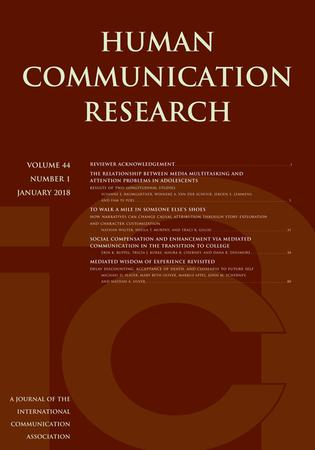关注源头:走向人机交流的一体化理论
IF 3.3
1区 文学
Q1 COMMUNICATION
引用次数: 0
摘要
计算机是社会行动者(CASA)范式是人机交互研究的主流理论框架,根据CASA范式,人们把计算机当作人来对待。然而,最近关于人机通信(HMC)和人类人工智能(AI)交互的研究似乎集中在人们何时以及如何对机器做出不同于人类代理人的反应。为了调和这一明显的矛盾,本研究批判性地回顾了在各自的传统中提出和检验的两种主要理论解释,即无意识解释和机器启发式。在详细阐述了每种解释机制的几个概念和操作问题之后,作者提出了一种替代的HMC理论模型,该模型整合了研究传统,并产生了可能偏离双过程模型的预测。最后,讨论了人工智能技术的最新发展如何改变当前对HMC及其以外的理解。本文章由计算机程序翻译,如有差异,请以英文原文为准。
Minding the source: toward an integrative theory of human–machine communication
Abstract According to the computers are social actors (CASA) paradigm, a dominant theoretical framework for research on human–computer interaction, people treat computers as if they were people. Recent studies on human–machine communication (HMC) and human–artificial intelligence (AI) interaction, however, appear to focus on when and how people respond to machines differently than to human agents. To reconcile this apparent contradiction, this study reviews critically the two overarching theoretical explanations proposed and tested in each respective tradition, the mindlessness account and the machine heuristic. After elaborating on several conceptual and operational issues with each explanatory mechanism, an alternative theoretical model of HMC is proposed that integrates both research traditions and generates predictions that potentially deviate from the dual-process models. Lastly, it is discussed how recent developments in AI technology invite modifications to the current understanding of HMC and beyond.
求助全文
通过发布文献求助,成功后即可免费获取论文全文。
去求助
来源期刊

Human Communication Research
COMMUNICATION-
CiteScore
8.20
自引率
2.00%
发文量
28
期刊介绍:
Human Communication Research is one of the official journals of the prestigious International Communication Association and concentrates on presenting the best empirical work in the area of human communication. It is a top-ranked communication studies journal and one of the top ten journals in the field of human communication. Major topic areas for the journal include language and social interaction, nonverbal communication, interpersonal communication, organizational communication and new technologies, mass communication, health communication, intercultural communication, and developmental issues in communication.
 求助内容:
求助内容: 应助结果提醒方式:
应助结果提醒方式:


